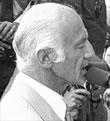PM No. 1 11/ 1972
ARMY RE-ORGANISAT ION
Statement by the Prime Minister the Right Honourable
William McMahon, CH, MP.
The Prime Minister, Mr. McMahon, announced today that
Cabinet had approved extensive changes in the command and
organisational structure of the Australian Army. The changes,
which will come into effect over the next three to five years,
follow consideration of the Report of the Army Review Committee
under the Chairmanship of Major-General F. G. Hassett.
The " Hassett Committee" was established by the
Minister for the Army, Mr. Peacock, in April 1970, and included
representatives of the Army and the Defence Departments.
The reorganisation of the Army is in keeping with the
Government's policy of modernising Australian Defence to meet
future contingencies. The experience the Army has gained from
Vietnam, the rapid advances in the field of communications and
changing strategic circumstances all indicate that reorganisation
will be necessary to meet defence tasks in the seventies and
eighties. The changes in organisation are designed to produce an
Army to meet these future needs.
They involve a reorganisat ion of the Australian
Army along functional lines in three broad areas:
* A change from a geographic system of command to a
functional system.
* A rationalization of logistic tasks.
A reorganization at Army Headquarters.
It is by far the biggest peace time change since
Federation and will result in an Army better organized to fulfil
its essential role in national defence.
One aspect of the reorganization requires emphasis.
It does not, in itself, involve any reduction or re-location of
units. It is essentially concerned with command and control and
does not affect the number and location of the Australian Regular
SArmy or the Citizen Military Force units It has been designed
amongst other things to avoid morale problems or posting turbulence
in the Army. The field force and logistic elements of the Army will
be grouped into Commonwealth-wide functional commands instead of
the present geographical command system. Army schools and training
establishments will also be centrali'ed under one command to ensure
uniformity of standards and methods and to avoid duplication.
Under the new organization Army Headquarters will be
relieved of its present responsibility for direct command of a
large number of units.
The new command system will bring about a greater
compatability of functional organisation between the three
Services and will facilitate any future developments in
rationalization of these Services.
The basis of the reorganization will be three new
functional commands concerned with the three principal functions
of an Army. A functional headquarters will have responsibility
3
on a Commonwealth wide basis as opposed to geographic headquarters
concerned with all functions within the area of the State in
which they are located. The three functional commands will be:
Field Force Command, with its headquarters in Sydney,
will consist of all Regular field force units and
initially all the CMF, HQ Ist Division as a part of
Field Force Command will be located in Brisbane to
command field force units in Queensland,
With this command in Sydney, the operational Headquarters
of the Army will be in the same areas as the operational
Headquarters of the Navy and the Air Force.
Logistic Command, with its headquarters in Melbourne,
will consist of Regular base units concerned with
transport, supply and repair.
Training Command, with its headquarters also in Sydney,
will consist of Army schools and training centres and
the Australian Cadet Corps. The headquarters will be
concerned with individual training and the development
of Army Headquarters.
As most CMF units are field force units, the whole of
the CMF will be placed initially under Field Force Command,
As the new system develops, CMF units will also take their
place in Logistic Command and Training Command to both of which
the CMF can bring a good deal of experience and knowledge in
specialist fields. 0 / 4
h 4.
A military District Headquarters in each State will
replace the present geographic Command Headquarters to handle
those matters which Pre best dealt with on a. geographic
basis. Logistic functions within the Am7y will be rationalized.
The principal logistic tasks which, at present, are the
responsibility of seven corps will be re-allotted and carried out
by three corps concerned with transport, supply and repair.
Major changes will also take place at Army
Headquarters. Initially the present four main military branches
will be retained, with some re-allotment of responsibilities.
These branches will be renamed Operations, Personnel, Logistics
and Material Branches,. In time, when Logistic Command is
established,. the number of main branches will be reduced to
three by amalgamating the interim Material and Logistics
Branches into a final phase Logistics Branch.
Mr. McMahon emphasised that the reorganized Army
would be better prepared to carry out its role in the defence
of Australia and its Territories and said that there would be
a more efficient and economic use made of manpower and funds
available to the Army.
26 January 1972.

